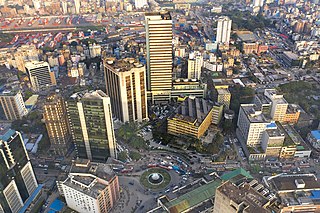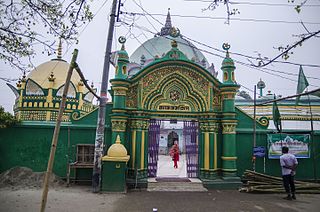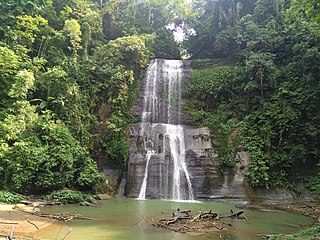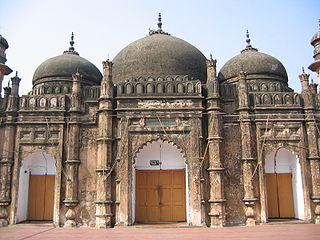
Bangladesh, officially the People's Republic of Bangladesh, is a country in South Asia. It is the eighth-most-populous country in the world, with a population of around 169 million people in an area of 148,460 square kilometres (57,320 sq mi). Bangladesh is among the most densely populated countries in the world, and shares land borders with India to the west, north, and east, and Myanmar to the southeast; to the south it has a coastline along the Bay of Bengal. It is narrowly separated from Bhutan and Nepal by the Siliguri Corridor; and from China by the Indian state of Sikkim in the north. Dhaka, the capital and largest city, is the nation's political, financial and cultural centre. Chittagong, the second-largest city, is the busiest port on the Bay of Bengal. The official language is Bengali, one of the easternmost branches of the Indo-European language family.

History of Bangladesh as a civilized nation goes back for more than four millennia to the Chalcolithic. The country's early recorded history is characterized by a succession of Hindu and Buddhist kingdoms and empires that fought for control of the Bengal region.

Dhaka, formerly known as Dacca, is the capital and largest city of Bangladesh. It is the ninth-largest and seventh-most densely populated city in the world. Dhaka is a megacity, and has a population of 10.2 million residents as of 2022, and a population of over 22.4 million residents in Greater Dhaka. It is widely considered to be the most densely populated built-up urban area in the world. Dhaka is the most important cultural, economic, and scientific hub of Eastern South Asia, as well as a major Muslim-majority city. Dhaka ranks third in South Asia and 39th in the world in terms of GDP. Lying on the Ganges Delta, it is bounded by the Buriganga, Turag, Dhaleshwari and Shitalakshya rivers. Dhaka is also the largest Bengali-speaking city in the world.

Barishal Division is one of the eight administrative divisions of Bangladesh. Located in the south-central part of the country, it has an area of 13,644.85 km2 (5,268.31 sq mi), and a population of 9,100,102 at the 2011 Census. It is the least populous Division within the entirety of Bangladesh. It is bounded by Dhaka Division on the north, the Bay of Bengal on the south, Chittagong Division on the east and Khulna Division on the west. The administrative capital, Barisal city, lies in the Padma River delta on an offshoot of the Arial Khan River. Barisal division is criss-crossed by numerous rivers that earned it the nickname Dhan-Nodi-Khal, Ei tin-e Borishal.

The Khulna Division is the second largest of the eight divisions of Bangladesh. It has an area of 22,285 km2 (8,604 sq mi) and a population of 17,416,645 at the 2022 Bangladesh census. Its headquarters and largest city is Khulna city in Khulna District.

Sirajganj District is a district in the North Bengal region of Bangladesh, located in the Rajshahi Division. It is an economically important district of Bangladesh. Sirajganj district is the 25th largest district by area and 9th largest district by population in Bangladesh. It is known as the gateway to North Bengal.

Moulvibazar also spelled Maulvibazar, Moulavibazar, and Maulavibazar, is the southeastern district of Sylhet Division in northeastern Bangladesh, named after the town of Moulvibazar. It is bordered by the Indian states of Tripura and Assam to the south and east, respectively; and by the Bangladeshi districts of Habiganj to the west and Sylhet to the north.

Dhaka District is a district in central Bangladesh, and is the densest district in the nation. It is a part of the Dhaka Division. Dhaka, the capital of Bangladesh, and rests on the eastern banks of the Buriganga River which flows from the Turag to the southern part of the district. While Dhaka occupies only about a fifth of the area of Dhaka district, it is the economic, political and cultural centre of the district and the country as a whole. Dhaka District consists of Dhaka, Keraniganj, Nababganj, Dohar, Savar and Dhamrai upazila. Dhaka District is an administrative entity, and like many other cities, it does not cover the modern conurbation which is Greater Dhaka, which has spilled into neighbouring districts, nor does the conurbation cover the whole district, as there are rural areas within the district.

Dhaka (Dacca) is one of the oldest inhabited mega cities of the World. The history of Dhaka begins with the existence of urbanised settlements in the area that is now Dhaka dating from the 7th century CE. The city area was ruled by the Hindu Gauda Kingdom, Buddhist and Shaivite Pala Empire before passing to the control of the Hindu Sena dynasty in the 10th century CE. After the Sena dynasty, the city was ruled by the Hindu Deva Dynasty. Dhaka was successively ruled by the Turkic and Afghan governors descending from the Delhi Sultanate, followed by the Bengal Sultanate, before the arrival of the Mughals in 1608. The city became proto-industrialised and declared capital of the Mughal Bengal and commercial (financial) capital of the Mughal India. The Dhaka natural riverine port has a recorded existence since the 16th century CE. Dhaka's strategic riverine location in Bengal made it a hub for Eurasian traders, including Armenians, the Portuguese, French, Dutch and British. The bustling old city was known as the Venice of the East. After Mughals, British ruled the region for 200 years until the independence of India in 1947. After the independence of Bangladesh in 1971, Dhaka became the capital of the new state.

Shahbagh is a major neighbourhood and a police precinct or thana in Dhaka, the capital and largest city of Bangladesh. It is also a major public transport hub. It is a junction between two contrasting sections of the city—Old Dhaka and New Dhaka—which lie, respectively, to its south and north. Developed in the 17th century during Mughal rule in Bengal, when Old Dhaka was the provincial capital and a centre of the flourishing muslin industry, it came to neglect and decay in early 19th century. In the mid-19th century, the Shahbagh area was developed as New Dhaka became a provincial centre of the British Raj, ending a century of decline brought on by the passing of Mughal rule.

The Khan_Mohammad_Mridha_Mosque is a historical mosque near Lalbagh Fort in Dhaka, Bangladesh.

Choto Katra is one of two Katras built during Mughal's regime in Dhaka, Bangladesh. It was constructed in 1663 by Subahdar Shaista Khan. It is on Hakim Habibur Rahman lane on the bank of the Buriganga River. It was built to accommodate officials and Shaista Khan's expanding family. Chhota Katra is slightly smaller than Bara Katra, but similar in plan and about 185 metres east of it.

Tourism in Bangladesh includes tourism to World Heritage Sites, historical monuments, resorts, beaches, picnic spots, forests, tribal people, and wildlife of various species. Activities for tourists include angling, water skiing, river cruising, hiking, rowing, yachting, and sea bathing.

Architecture of Bangladesh is intertwined with the architecture of the Bengal region and the broader Indian subcontinent. The architecture of Bangladesh has a long history and is rooted in Bangladesh's culture, religion and history. It has evolved over centuries and assimilated influences from social, religious and exotic communities. The architecture of Bangladesh bears a remarkable impact on the lifestyle, tradition and cultural life of Bangladeshi people. Bangladesh has many architectural relics and monuments dating back thousands of years.

The Kartalab Khan Mosque or Begum Bazar Mosque, in the Begum Bazar area in old Dhaka, Bangladesh, was built by Nawab Diwan Murshid Quli Khan between 1700 and 1704. The mosque consists of a high valuated platform, a mosque with a 'dochala' annex on the north upon the western half of the platform and a 'baoli' to the east of the platform. It is roofed by five domes resting on octagonal drums. The mosque was extensively renovated by Mirza Golam Pir in the nineteenth century. In accordance with Murshid Quli Khan's wishes, he was buried under the entrance to this mosque.

The city of Chattogram (Chittagong) is traditionally centred around its seaport which has existed since the 4th century BCE. One of the world's oldest ports with a functional natural harbor for centuries, Chittagong appeared on ancient Greek and Roman maps, including on Ptolemy's world map. Chittagong port is the oldest and largest natural seaport and the busiest port of Bay of Bengal. It was located on the southern branch of the Silk Road. The city was home to the ancient independent Buddhist kingdoms of Bengal like Samatata and Harikela. It later fell under of the rule of the Gupta Empire, the Gauda Kingdom, the Pala Empire, the Sena Dynasty, the Deva Dynasty and the Arakanese kingdom of Waithali. Arab Muslims traded with the port from as early as the 9th century. Historian Lama Taranath is of the view that the Buddhist king Gopichandra had his capital at Chittagong in the 10th century. According to Tibetan tradition, this century marked the birth of Tantric Buddhism in the region. The region has been explored by numerous historic travellers, most notably Ibn Battuta of Morocco who visited in the 14th century. During this time, the region was conquered and incorporated into the independent Sonargaon Sultanate by Fakhruddin Mubarak Shah in 1340 AD. Sultan Ghiyasuddin Azam Shah constructed a highway from Chittagong to Chandpur and ordered the construction of many lavish mosques and tombs. After the defeat of the Sultan of Bengal Ghiyasuddin Mahmud Shah in the hands of Sher Shah Suri in 1538, the Arakanese Kingdom of Mrauk U managed to regain Chittagong. From this time onward, until its conquest by the Mughal Empire, the region was under the control of the Portuguese and the Magh pirates for 128 years.

Bengali Muslims are ethnic, linguistic and genealogical Bengalis who adhere to Islam. Comprising about two-thirds of the global Bengali population, they are the second-largest ethnic group among Muslims after Arabs. Bengali Muslims make up the majority of Bangladesh's citizens, and are the largest minority in the Indian states of West Bengal, Tripura and Assam.

The zamindars of Mahipur were a Bengali aristocratic family of feudal landowners. The zamindari estate encompassed the Chakla of Qazirhat under the Cooch Behar State since the Mughal period. Although their aristocratic status was lost with the East Bengal State Acquisition and Tenancy Act of 1950, the Mahipur estate remains an important part of the history of Rangpur and belongs to one of the eighteen ancient zamindar families of Rangpur. The zamindari palace was lost as a result of flooding from the Teesta River, although the mosque, cemetery, polished reservoir and large draw-well can still be seen today.

Abū az-Zibriqān ʿAbd ar-Raḥmān ibn ʿAbd al-Hādī Dāmullā al-Kāshgharī an-Nadwī, or simply Abdur Rahman Kashgari, was one of the leading scholars of the Arabic language and literature in the Indian subcontinent. Of Uyghur background, Kashgari migrated from East Turkestan to India at an early age, completing his studies in Lucknow where he became an accomplished Islamic scholar, linguist, poet and author. He then migrated to Bengal, where he eventually became the principal of Dhaka Alia Madrasa. Kashgari was also the first khatib of the Baitul Mukarram National Mosque, holding this role until his death.

Shāh Nūrī Bengālī was an 18th-century Bengali Islamic scholar and author from Dhaka. He is best known for his magnum opus, Kibrīt-e-Aḥmar, which was written in the Persian language.



















